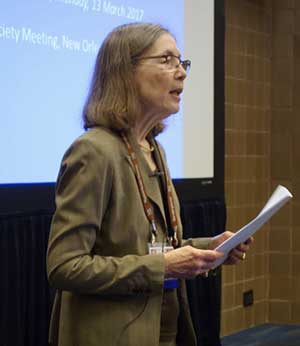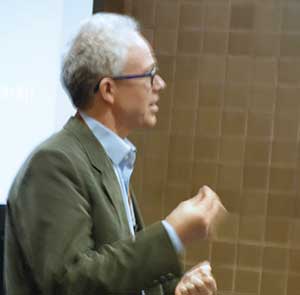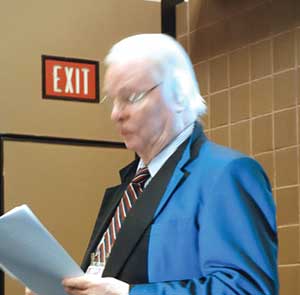March 2017 Meeting Session Reports: “The Pais Prize Session for Mary Jo Nye”
By Joseph D. Martin, University of Cambridge
Nowhere is better suited than New Orleans to honor the work of Mary Jo Nye, winner of the 2017 Abraham Pais Prize for History of Physics. The city blends artistic, musical, linguistic, and culinary influences from a vibrant collection of cultural traditions, and so presented a fitting backdrop for a celebration of Nye’s contributions to history of physics, which have often examined how methods, theories, and practices blend in the spaces where scientific disciplines meet. The Forum on the History of Physics–sponsored prize session at the APS March meeting showcased work that followed Nye’s spirit of exploring boundaries between disciplines and discussing the interfaces between science and politics.
Nye herself spoke on one of the issues that has defined her career, asking how the boundaries of physics have evolved since the beginning of the twentieth century. She used the broad perspective her work provides to examine how the history of physics has responded—or not—to the prevailing winds of the physics profession. Nye’s analysis showed that historians of physics have largely reproduced the prestige hierarchies that exist in physics itself, focusing their attentions on relativity, quantum mechanics, and nuclear and high energy physics. But she also identified recent trends that show the field waking to the wider collection of investigations that often move fluidly across the boundaries of the physics, such as solid state and condensed matter physics, chemical physics, and plasma physics. The challenges of dealing with the richness and complexity of late-twentieth century physics, and especially those activities that push up against disciplinary boundaries, Nye suggested, should make historians of physics more open to the types of multi-author collaborations now standard in physics itself.
Two previous Pais Prize winners joined the panel to speak in Nye’s honor, the first being Allan Franklin. Franklin was awarded last year’s prize for his trailblazing work on the history of experiment, and his talk furthered in that line of research, tracing the difference between direct and indirect experimental detection through a number of examples from twentieth-century physics. This history has become particularly important in light of the recent gravitational wave observations at LIGO—which directly recorded a phenomenon that had previously been indirectly inferred, leading the physics community to mull how to apportion credit for the discovery, and the accolades likely to accompany it. Franklin’s case studies suggest that the distinction between direct and indirect observation is not always so powerful an arbitrator of these questions as we might expect it to be. In some cases, direct observations carry greater weight, but in others, the indirect inferences are what we remember as the groundbreaking discoveries. If therefore behooves historians to consider what other factors might guide our instincts about which is more important for a particular episode.
Richard Staley, following Franklin, paid tribute to Nye’s perceptive work on boundaries by considering the interfaces between physics and physiology. In a professional world so thoroughly compartmentalized by specialization, it is easy to forget that many of those we remember for their contributions to physics were also fascinated by physiological phenomena. For figures like Ernst Mach and Hermann von Helmholtz, understanding physical phenomena like light, space, and motion meant probing the bodily mechanisms governing sight, hearing, and balance. The same thinkers willing to map out the boundary between physics and physiology were often also those who were likely to navigate into politics. Machism, Marxism, and mechanism became intertwined in the second half of the 1800s for those natural philosophers who, like Mach, were as skeptical of absolute boundaries between areas of knowledge as they were of absolute space, absolute despots, and absolute notions of selfhood.
“What Kuhn has been dishing us is nonsense” was the take-away from Michael Nauenberg’s talk on the origins of the quantum. The nonsense in question refers to a long and contentious debate about the conceptual origins of the quantum. Thomas Kuhn suggested that historians withhold the blue riband from Max Planck and award it instead to Albert Einstein. The former might have nominally quantized the energy spectrum in 1900 in the course of his efforts to explain black-body radiation, Kuhn argued, but it was Einstein who fully committed to the idea when he introduced light quanta in 1905. Nauenberg quoted Einstein’s advice to examine what physicists do, rather than what they say they did, when tracing their histories to argue that Kuhn did Planck an injustice.
Rounding out the session was the symposium’s second former Pais Prize winner, Roger Stuewer, who began his career in the history of science alongside Nye in the University of Wisconsin’s graduate program. Stuewer shared his renowned expertise in the history of nuclear physics. He juxtaposed his narrative account of the evolving understanding of the nucleus and nuclear fission with a discussion of the concurrent political developments that led to World War II. Scientific understanding of the disintegration of the nucleus marched in lockstep with the disintegration of Europe, and the political fissions of the 1930s scattered the European scientists responsible for knowledge of nuclear fission across the globe. Coming to rest in more stable political environs, they sparked new interest in nuclear physics worldwide.
Stuewer, in closing, noted the injustice of denying Lise Meitner a Nobel Prize, echoing Nye’s observation of the dearth of women among physics laureates. Nye observed that the stark gender disparity in physics has been cast in relief by the recent deaths of Vera Rubin and Mildred Dresselhaus, both of whom achieved just about every honor physics has to offer except its highest. A session devoted to work that crosses boundaries therefore offered ample opportunity to reflect on the boundaries that remain, in both physics and the history of physics. The physics profession opened up to boundary-crossing physical investigation in the late twentieth century, but significant boundaries, built on race, class, and gender, persist for physicists themselves. And engaging the boundary-crossing topics and approaches that define recent physics will necessarily require breaking down similar boundaries for those studying its history.

Mary Jo Nye of Oregon State University




Allan Franklin of the University of Colorado (top), Michael Nauenberg of the University of California, Santa Cruz (2nd from top), Richard Staley of the University of Cambridge (2nd from bottom) and Roger Stuewer of the University of Minnesota (bottom)
The articles in this issue represent the views of their authors and are not necessarily those of the Forum or APS.
